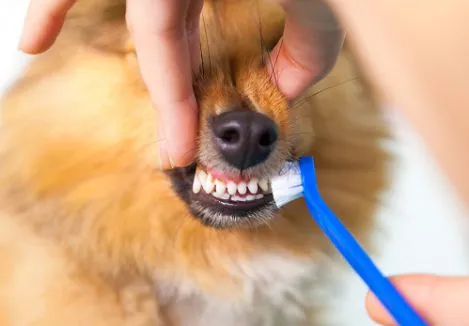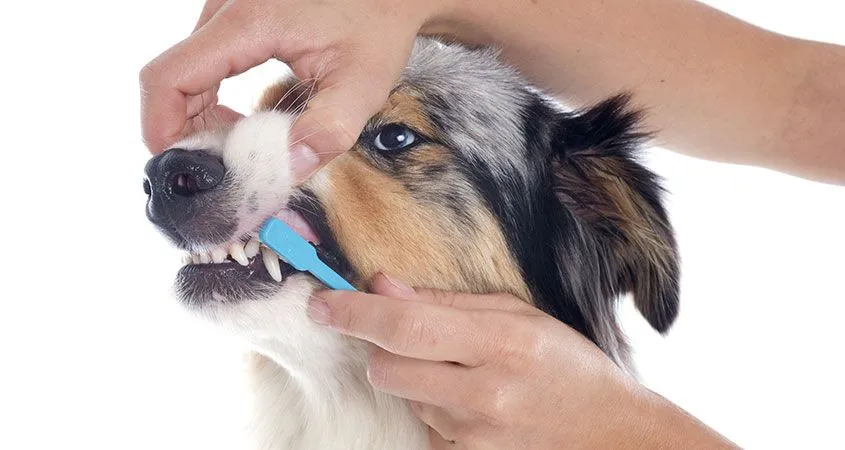Table of Contents
Key Takeaways
- Taking care of your pet’s teeth and gums is essential to maintaining good health
- Just like in people, gum disease, cavities, and mouth ulcers can occur in pets.
- Frequent home brushing and professional cleanings when needed are recommended for good oral health.
On average, people brush their teeth twice a day and visit their dentist every six months. But how often do you provide dental care for your dog or cat? Many of the same dental illnesses and conditions humans develop are also developed by pets. Taking care of your pet’s teeth and gums is essential to maintaining good health; and just like in humans, complications can arise from diseases left untreated.
Common Conditions
- Periodontal gum disease is the biggest threat to your pet’s dental health. It develops when bacteria build up on teeth and under the animal’s gum line, combining with saliva and bits of food to form plaque, which then hardens and calcifies into tartar. Plaque and tartar are very irritating, and over time, the gums begin to separate from the teeth. If left untreated, infections and abscesses can form, causing extreme pain and problems eating. Reddened gums and excessively bad breath are initial indicators while receding gums are visible in the disease’s later stages. If an abscess is present, facial swelling, bad breath, and an inability to chew normally may be noticeable. Professional teeth cleaning is required to remove the plaque and tartar, and in advanced cases, teeth may have to be removed.
- Cavities are common in people but less so in pets. Just as in humans, cavities result from the decaying of hard tooth tissue due to a build-up of bacteria. A cavity may be visible on your pet’s tooth, but often there are no other symptoms. The hole in your pet’s tooth may be filled by a veterinary dentist, but if the tooth has decayed too much it may have to be removed. Cats more commonly develop a condition called tooth resorption, which is a bit like a huge cavity that eats away at one or more teeth. Tooth resorption is extremely painful.
- Tissue inflammation, ulcers, and wounds in the mouth are other concerns for pet parents. While some pre-existing medical conditions such as diabetes and lupus can cause these problems, there are also many other causes. Malnutrition, an electrical shock injury, or trauma to the mouth can all cause mouth inflammation, wounds, and ulcers. Symptoms include bad breath, red and swollen gums, “ropey” saliva, pain, and loss of appetite. Veterinary care depends on the underlying cause, but most often drugs will be prescribed to reduce inflammation and pain and to treat or prevent infection.
Visiting Your Vet
If you notice any unusual changes in your pet’s eating habits, including loss of appetite and problems chewing, seek veterinary care. Any visible malformations of your cat or dog’s gums, cheeks, tongue, or teeth should also be reasons to make an appointment. If you have a puppy or kitten, pay close attention to your pet’s teeth as they develop; crowded teeth can also cause inflammation and pain as well as structural anomalies that may require treatment to correct.
Preventing Dental Issues
It is recommended that your pet visit a vet for professional teeth cleanings on an as-needed basis. Some pets should have their teeth cleaned once a year or even more frequently. Others, particularly those whose teeth are brushed daily, do fine with less frequent cleanings. A professional dental cleaning is a multistep procedure that can ensure your pet’s continued health.

- Physical exam.
Because teeth cleaning requires your pet to be put under anesthesia, an exam is needed to ensure he or she is healthy enough to undergo the procedure. Blood and urine tests may be run depending on your pet’s medical history, age, and other factors. An exam will also be performed specifically on the mouth and face area to start diagnosing any abnormalities and target specific areas for treatment. - Exam under anesthesia.
Your dog or cat must be anesthetized to thoroughly examine their mouth and clean their teeth. A veterinary technician will closely monitor your pet’s condition throughout the procedure and keep an eye on vital signs, including heartbeat and body temperature. A more in-depth exam will be conducted by the vet to further look for dental conditions such as cavities, periodontal disease, and ulcers. - Tooth cleaning.
Ultrasonic cleaning tools along with hand instruments will be used to remove plaque and tartar from the teeth, including under the gum line. - Tooth polishing.
With a high-speed hand tool, the vet or technician will smooth and even out the surface of your dog or cat’s teeth. - Fluoride.
This liquid is brushed onto your pet’s teeth and works to harden enamel. - Post-cleaning exam.
Dental x-rays are often taken because many dental problems hide under the gumline and can’t be seen during an exam. Additional treatments may be performed or scheduled for a future date.
Of course, pet parents should continue to care for their pet’s dental health at home with regular tooth brushings.
What Pet Insurance Covers
Healthy Paws pet insurance plans cover accidental injury to your dog or cat’s teeth, including extractions and reconstructions. Routine dental care, such as the professional cleanings described above, is considered preventative and is not covered. Taking care of your dog or cat’s dental health is essential to keeping a healthy pet. With preventative at-home and professional cleanings, you can help keep dental disease at bay.








